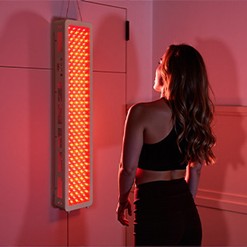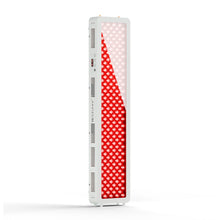Quick Answer
Yes, at-home red light therapy for gums does work according to scientific research, but with important qualifications. Studies show it reduces inflammation and improves healing when used consistently for 5-15 minutes daily, with visible results typically appearing after 4-12 weeks. However, it works best as a supplement to regular dental care, not a replacement for it.

Introduction
Red light therapy is gaining attention as a simple way to help with gum health at home. The treatment uses specific red light wavelengths that might reduce swelling, help healing, and boost blood flow to your gums. Many people now add these light devices to their daily routine along with regular brushing and flossing. With more affordable options available, you might wonder if these devices actually work, how to use them safely, and what benefits they offer. The science looks promising, but it's important to know where this treatment fits in your overall dental care.
What Is Red Light Therapy and How Does It Work?
Red light therapy uses specific wavelengths of light to stimulate cellular activity in your body. This technology has moved from clinical settings to homes as more affordable devices become available. The treatment involves exposing your skin or tissues to red light wavelengths between 630-660 nanometers, which penetrate below the surface to reach cells and potentially trigger healing responses.
How Light Affects Your Cells
When red light reaches your cells, it interacts with mitochondria—the energy-producing parts of your cells. This process, called photobiomodulation, stimulates the mitochondria to produce more adenosine triphosphate (ATP), which is your body's main energy currency. The increased energy helps cells function better, repair themselves faster, and reduce inflammation. In gum tissue specifically, this cellular boost may help strengthen the tissue, fight bacteria, and support healing of damaged areas.
Different Types of Light Treatments
Red light therapy differs significantly from other light-based treatments you might have heard about. Unlike UV light (which damages skin cells) or laser treatments (which can destroy tissue), red light therapy doesn't harm tissues—it works by stimulating your body's natural processes. Blue light therapy, sometimes used for acne, targets bacteria on the skin's surface. Near-Infrared light penetrates deeper than red light but works on similar principles. For oral care specifically, red light occupies a sweet spot—penetrating deeply enough to reach gum tissue while remaining gentle enough for regular home use without specialist supervision.
How Red Light Therapy May Help Your Gums
Now that we understand how red light affects cells, we can see why it might benefit gum health specifically. The same cellular energy boost that red light therapy provides throughout the body can target the specialized tissues in your gums, potentially addressing common problems like inflammation and poor circulation.
Reduces Swelling and Bleeding
Red light therapy helps calm inflamed gums by targeting the root causes of irritation. The specific wavelengths penetrate gum tissue and reduce inflammatory responses, leading to less redness, swelling, and bleeding when you brush or floss. Most people notice their gums bleed less during regular oral care after a few weeks of consistent treatment.
Speeds Up Healing
The light energy stimulates your cells' natural healing capabilities, so gum tissues heal faster. This is especially helpful after dental cleanings or if you get mouth sores regularly. The quicker healing means less pain and quicker recovery from minor gum injuries or irritation.
Improves Blood Circulation
Red light therapy improves blood flow to your gums by opening and relaxing small blood vessels. Improved circulation brings more oxygen and nutrients to gum tissue while removing waste products. The result is healthier, pinker gums rather than pale or receding tissue accompanying poor circulation.
Fights Harmful Bacteria
The light helps to create conditions in your mouth that are less favorable for harmful bacteria. While it does not directly kill bacteria like antibiotics do, it enhances your body's natural defense in the gum area, which results in a healthier oral bacterial balance without the use of chemicals.
Types of Home Red Light Devices for Oral Care
When purchasing a red light therapy device for your gums, you have several choices that vary according to design, coverage, and price. The following are the most prominent types:
- Handheld Wands ($30-150): These are small devices that enable you to treat specific regions in your mouth. They are cost-effective and perfect for spot treatment but require manual positioning.
- Mouthpiece Devices ($100-300): Shaped like athletic mouth guards, these provide full coverage to all gum surfaces simultaneously. They're hands-free and ensure consistent treatment to your entire mouth.
- Combination Wavelength Devices: Both red light (630-660nm) and near-infrared wavelengths are employed by these devices to treat surface gum tissue and internal structures simultaneously.
- Professional-Grade Systems ($300+): Stronger units producing higher-intensity light therapy, often featuring various treatment modes and timer controls for consistent usage.
- Toothbrush Attachments: There are some newer products that combine LED light therapy with regular toothbrushes, though these typically offer less light therapy than dedicated devices.

What to Know Before Starting Red Light Therapy for Your Gums
Red light therapy offers a promising approach to supporting gum health, but it's important to understand what it can and cannot do before investing in a home device.
- How It Helps Your Gums: Red light can reduce inflammation, improve blood flow to your gums, and help with healing after dental procedures. Many people notice less bleeding when brushing and flossing after regular use.
- Works Best as a Complement: Red light therapy works better alongside regular dental care, not as a replacement. Continue brushing, flossing, and seeing your dentist for checkups.
- Results Take Time: Most people need consistent treatment for several weeks before seeing noticeable improvements in their gum health.
- Generally Very Safe: Side effects are minimal for most people. You might experience temporary sensitivity or mild tingling in your gums when first starting treatment.
- Use Caution If: Check with your doctor before using if you take medications that make you sensitive to light. People with oral cancer should avoid using red light therapy.
- Protect Your Eyes: Always follow the device instructions for eye safety, as the bright light shouldn't be directed into your eyes.
- Quality Varies: Home devices aren't all created equal. Higher-priced options typically provide better light intensity and coverage than very cheap alternatives.
How to Add Red Light Therapy to Your Dental Care Routine
Adding red light therapy to your daily tooth care might help your gums heal better. Here's how to do it right without wasting time or money.
Step 1: Consult Your Dental Professional
Before buying a red light product, discuss your case with your dentist. Your dental expert can assess if this treatment could be good for your specific gum condition and monitor its progress over time.
This conversation is especially important if you have a previous periodontal disease, dental implants, or recent oral surgery. Come prepared with information on the specific device you wish to use, including wavelength and power rating. Your dentist can recommend changes in the treatment protocol based on your oral health status.
Step 2: Choose the Right Device
Select a red light therapy unit specifically marked as oral use. Look for red light therapy devices that contain the proper wavelength (most often 630-660 nm for red light) and sufficient power output to be effective.
Consider ease of use, product life, and whether it will specifically deal with your own issues. Some are designed for whole-mouth treatment, while others target problem areas with precision. Your budget will also be taken into account, but remember, quality matters with therapeutic devices.
Step 3: Maintain Your Regular Oral Care Routine
Red light therapy would supplement but not substitute your already established oral hygiene routine. Continue brushing twice a day with fluoride toothpaste, floss daily, and adhere to the advice of your dentist on using antimicrobial mouthwash.
Light therapy will work best if applied to clean gum tissue, so apply it after your regular cleaning appointment. Red light can be thought of as a supporting actor that helps your body's own healing processes to work more efficiently while your primary care addresses the root causes of gum problems.
Step 4: Establish a Treatment Schedule
Create a routine schedule for your red light therapy treatments. The majority of units recommend daily use for a period of time (typically 5-10 minutes per treatment).
Start with the frequency recommended by the manufacturer, but be prepared to adjust based on your dentist's advice and your gums' response. Some people achieve the best results with twice-daily treatments, while others see benefits with only a few treatments per week.
Step 5: Monitor Your Progress
Monitor gum health shifts as you go through red light therapy. Note improvements in gum color, reduced bleeding when you brush or floss, and sensitivity adjustments.
Take photos of your gums when you start treatment as a reference point. If no changes are observed after weeks of regular use, discuss altering your approach with your dentist.
Step 6: Continue Regular Dental Check-ups
Regular dental check-ups are still necessary, as they can detect issues that red light therapy by itself will not fix, like cavities or structural problems.
Your dentist can advise whether your at-home treatment is yielding the desired results or whether professional treatments are required. Regular check-ups are also a time to adjust your red light therapy regimen based on professional input.
Try Red Light Therapy For Healthier Gums
Red light therapy actually does work to improve your gum health. This simple process can decrease swelling, heal faster, and deliver blood flow to your gums when performed daily. The best news? You can do it from home in just minutes a day.
If you're dealing with sensitive gums or the early stages of gum problems, adding a red light device to your daily care routine might be just what you need. Get a good quality device with the correct wavelengths (630-660nm), use it for 5-15 minutes a day after brushing and flossing, and be patient—most people notice improvements after a few weeks of regular use.
Just remember that red light therapy is most effective in complementing your regular dental practice, not instead of. Talk to your dentist first, especially if you have ongoing oral issues. They can help monitor your progress and make sure this technique is safe for you.
Ready to give your gums some special love? A daily treatment of red light therapy could be the simple pick-me-up your smile requires.
FAQs About Red Light Therapy for Gum Health
Q1: Is red light therapy FDA-approved for gum treatment?
Yes. Most at-home red light devices for gum health are FDA-cleared as Class II medical devices for improving circulation and reducing pain, but not specifically approved for treating gum disease.
Q2: How long before I see results from red light therapy on my gums?
Most users notice improvements in gum sensitivity and bleeding after 4-6 weeks of consistent daily use, though individual results vary depending on your specific condition.
Q3: Can red light therapy replace professional dental cleanings?
No. Red light therapy should complement, not replace, professional dental cleanings which remove plaque and tartar that light therapy cannot address.















 Small
Small

 Moderate
Moderate

 Moderate
Moderate

 Moderate
Moderate

 Full
Full



